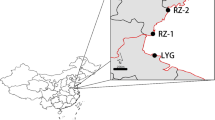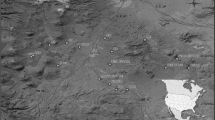Abstract
The nitrogen-fixing tree black locust (Robinia pseudoacacia L.) seems to affect ectomycorrhizal (ECM) colonization and disease severity of Japanese black pine (Pinus thunbergii Parl.) seedlings. We examined the effect of black locust on the distribution of ECM and pathogenic fungi in soil. DNA was extracted from soil at depths of 0–5 and 5–10 cm, collected from the border between a Japanese black pine- and a black locust-dominated forest, and the distribution of these fungi was investigated by denaturing gradient gel electrophoresis. The effect of soil nutrition and pH on fungal distribution was also examined. Tomentella sp. 1 and Tomentella sp. 2 were not detected from some subplots in the Japanese black pine-dominated forest. Ectomycorrhizas formed by Tomentella spp. were dominant in black locust-dominated subplots and very little in the Japanese black pine-dominated forest. Therefore, the distribution may be influenced by the distribution of inoculum potential, although we could not detect significant relationships between the distribution of Tomentella spp. on pine seedlings and in soils. The other ECM fungi were detected in soils in subplots where the ECM fungi was not detected on pine seedlings, and there was no significant correlation between the distribution of the ECM fungi on pine seedlings and in soils. Therefore, inoculum potential seemed to not always influence the ECM community on roots. The distribution of Lactarius quieticolor and Tomentella sp. 2 in soil at a depth of 0–5 cm positively correlated with soil phosphate (soil P) and that of Tomentella sp. 2 also positively correlated with soil nitrogen (soil N). These results suggest the possibility that the distribution of inoculum potential of the ECM fungi was affected by soil N and soil P. Although the mortality of the pine seedlings was higher in the black locust-dominated area than in the Japanese black pine-dominated area, a pathogenic fungus of pine seedlings, Cylindrocladium pacificum, was detected in soil at depths of 0–5 and 5–10 cm from both these areas. This indicates that the disease severity of pine seedlings in this study was influenced by environmental conditions rather than the distribution of inoculum potential.


Similar content being viewed by others
References
Deacon JW, Donaldson SJ, Last FT (1983) Sequences and interactions of mycorrhizal fungi on birch. Plant Soil 71:257–262. doi:10.1007/BF02182660
Dickie IA, Xu B, Koide RT (2002) Vertical niche differentiation of ectomycorrhizal hyphae in soil as shown by T-RFLP analysis. New Phytol 156:527–535. doi:10.1046/j.1469-8137.2002.00535.x
Ford ED, Mason PA, Pelham J (1980) Spatial patterns of sporophore distribution around a young birch tree in three successive years. Trans Br Mycol Soc 75:287–296
Gardes M, Bruns TD (1993) ITS primers with enhanced specificity for basidiomycetes application to the identification of mycorrhizae and rust. Mol Ecol 2:113–118. doi:10.1111/j.1365-294X.1993.tb00005.x
Hoshino YT, Matsumoto N (2004) An improved DNA extraction method using skim milk from soils that strongly adsorb DNA. Microbes Environ 19:13–19. doi:10.1264/jsme2.19.13
Kimura K (1995) Soil chemical properties. In: Hinata K, Hashiba T (eds) A manual of experiments for plant biology (in Japanese). Soft Science, Tokyo, pp 322–327
Koide RT, Xu B, Sharda J (2005) Contrasting below-ground views of an ectomycorrhizal fungal community. New Phytol 166:251–262. doi:10.1111/j.1469-8137.2004.01313.x
Molina R, Massicotte H, Trappe JM (1992) Specificity phenomena in mycorrhizal symbioses: community–ecological consequences and practical implications. In: Allen MF (ed) Mycorrhizal functioning. Chapman & Hall, New York, USA, pp 357–423
Parrent JL, Vilgalys R (2007) Biomass and compositional responses of ectomycorrhizal fungal hyphae to elevated CO2 and nitrogen fertilization. New Phytol 176:164–174. doi:10.1111/j.1469-8137.2007.02155.x
Parrent JL, Morris WF, Vilgalys R (2006) CO2-enrichment and nutrient availability alter ectomycorrhizal fungal communities. Ecology 87:2278–2287. doi:10.1890/0012-9658(2006)87[2278:CANAAE]2.0.CO;2
Peter M, Ayer F, Egli S (2001) Nitrogen addition in a Norway spruce stand altered macromycete sporocarp production and belowground ectomycorrhizal species composition. New Phytol 149:311–325. doi:10.1046/j.1469-8137.2001.00030.x
Taniguchi T, Kanzaki N, Tamai S, Yamanaka N, Futai K (2007a) Does ectomycorrhizal fungal community structure vary along a Japanese black pine (Pinus thunbergii) to black locust (Robinia pseudoacacia) gradient? New Phytol 173:322–334. doi:10.1111/j.1469-8137.2006.01910.x
Taniguchi T, Tamai S, Yamanaka N, Futai K (2007b) Inhibition of the regeneration of Japanese black pine (Pinus thunbergii) by black locust (Robinia pseudoacacia) in a coastal sand dune. J For Res 12:350–357. doi:10.1007/s10310-007-0023-y
Taniguchi T, Kataoka R, Futai K (2008a) Plant growth and nutrition in pine (Pinus thunbergii) seedlings and dehydrogenase and phosphatase activity of ectomycorrhizal root tips inoculated with seven individual ectomycorrhizal fungal species at high and low nitrogen conditions. Soil Biol Biochem 40:1235–1243. doi:10.1016/j.soilbio.2007.12.017
Taniguchi T, Tanaka C, Tamai S, Yamanaka N, Futai K (2008b) Identification of Cylindrocladium sp. causing damping-off disease of Japanese black pine (Pinus thunbergii) and factors affecting the disease severity in a black locust (Robinia pseudoacacia)-dominated area. J For Res 13:233–240. doi:10.1007/s10310-008-0076-6
Truog E (1930) The determination of the readily available phosphorus of soils. J Am Soc Agron 22:874–882
Volossiouk T, Robb EJ, Nazar RN (1995) Direct DNA extraction for PCR-mediated assays of soil organisms. Appl Environ Microbiol 61:3972–3976
White TJ, Bruns TD, Lee S, Taylor J (1990) Amplification and direct sequencing of fungal ribosomal RNA genes for phylogenetics. In: Innis MA, Gelfand DH, Sninsky JJ, White TJ (eds) PCR protocols: a guide to methods and applications. Academic, New York, pp 315–322
Acknowledgments
This study was a joint research by the Graduate School of Agriculture, Kyoto University, and Arid Land Research Center, Tottori University. We thank Dr. Michimasa Yamasaki, Graduate School of Agriculture, Kyoto University, for the measurement of soil C and soil N. We are also grateful to Dr. Zaki A. Siddiqui, Aligarh Muslim University, for checking the manuscript.
Author information
Authors and Affiliations
Corresponding author
Rights and permissions
About this article
Cite this article
Taniguchi, T., Kataoka, R., Tamai, S. et al. Distribution of ectomycorrhizal and pathogenic fungi in soil along a vegetational change from Japanese black pine (Pinus thunbergii) to black locust (Robinia pseudoacacia). Mycorrhiza 19, 231–238 (2009). https://doi.org/10.1007/s00572-008-0212-3
Received:
Accepted:
Published:
Issue Date:
DOI: https://doi.org/10.1007/s00572-008-0212-3




